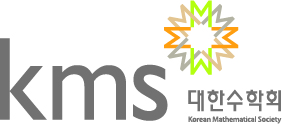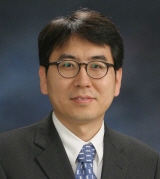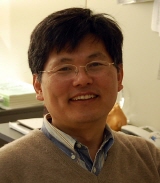2014년도 대한수학회 봄 연구발표회
(2014 KMS Spring Meeting)
2014. 4. 24(목) ~ 26(토), 강릉원주대학교(강릉캠퍼스)

2014. 4. 24(목) ~ 26(토), 강릉원주대학교(강릉캠퍼스)
◎ Plenary Lecture (4.25(금))
 |
김영훈 Kiem, Young-Hoon • 서울대학교 수리과학부 교수 Professor, Department of Mathematical Sciences, Seoul National University Title: Categorification of Donaldson-Thomas invariants by perverse sheaves In 1980s, Donaldson discovered his famous invariant of 4-manifolds which was subsequently proved to be an integral on the moduli space of semistable sheaves when the 4-manifold is an algebraic surface. In 1994, the Seiberg-Witten invariant was discovered and conjectured to be equivalent to the Donaldson invariant (still open). In late 1990s, Taubes proved that the Seiberg-Witten invariant also counts pseudo-holomorphic curves. The Donaldson-Thomas invariant of a Calabi-Yau 3-fold Y (complex projective manifold of dimension 3 with nowhere vanishing holomorphic 3-form) can be thought of as a generalization of the Donaldson invariant. It was defined by virtual integrals on the moduli space of stable sheaves on Y and expected to count algebraic curves in Y. The categorification conjecture due to Kontsevich-Soibelman, Joyce-Song, Behrend-Bryan-Szendroi and others claims that there should be a cohomology theory on the moduli space of stable sheaves whose Euler number coincides with the Donaldson-Thomas invariant. I will talk about recent progress about the categorification conjecture by using perverse sheaves. Locally the moduli space is the critical locus of a holomorphic function on a complex manifold called a Chern-Simons chart and we have the perverse sheaf of vanishing cycles on the critical locus. By constructing suitable Chern-Simons charts and homotopies using gauge theory, it is possible to glue the perverse sheaves of vanishing cycles to obtain a globally defined perverse sheaf whose hypercohomology is the desired categorified Donaldson-Thomas invariant. As an application, we can provide a mathematical theory of the Gopakumar-Vafa (BPS) invariant. I will also discuss wall crossing formulas for these invariants. |
◎ Public Lecture (4.24(목))
 |
서진근 Seo, Jin Keun • 연세대학교 계산과학공학과 교수 Professor, Department of Computational Science and Engineering, Yonsei University Title: 수학적 사고와 계산과학 과학은 논리적인 이론과 관찰/실험을 통한 현실검증이라는 두 중심축에 의해 발전하였다. 이러한 과학적인 방법론은 인류를 미신, 무지와 편견으로부터 벗어나 체계적이고 합리적인 사고를 하는데 공헌하였다. 현대과학의 제1축인 이론, 제 2의 축인 관찰/실험과 더불어 최근에는 현대과학의 제 3의 축으로 컴퓨터의 발전에 힘입은 수학기반의 계산과학이 활용되고 있다. 계산과학은 자연현상을 수학적인 논리체계하에서 기술하고 수리모델링 및 시뮬레이션을 통해 가시화함으로써 자연현상을 설명한다. 계산과학은 의료영상, 거대 자연현상 예측에서부터 생명과학, 빅데이터 계산에 이르기까지 그 영역을 급속히 확대해가고 있다. 본 강연에서는 계산과학에서 수학적 사고의 중요성을 설명하고자 한다. |
◎ Invited Lectures (4.25(금)~4.26(토))
| [Algebra] 금종해 Keum, Jong Hae • 고등과학원 수학부 교수 Professor, School of Mathematics, Korea Institute for Advanced Study • 2013년도 대한수학회상 학술상 수상자 The winner of 2013 KMS Academic Achievement Award Title: Derived Categories of fake projective planes which cover a (2,3)-Dolgachev surface It is known that a compact complex manifold of dimension 2 with the same Betti numbers as the complex projective plane is projective. Such a manifold is called a fake projective plane if it is not isomorphic to the complex projective plane. A fake projective plane has betti numbers, $b_1=0$, $b_2=1$, hence $q=p_g=0$, $c_2=3$ and by Noether formula $c_1^2=9$. Either its canonical class or its anti-canonical class is ample. The latter case yields the complex projective plane. So a fake projective plane is exactly a smooth surface of general type with $p_g=0$ and $c_1^2=3c_2=9$. By Aubin and Yau, its universal cover is the unit complex 2-ball and hence its fundamental group $\pi_1(X)$ is infinite. More precisely, $\pi_1(X)$ is a discrete torsion-free cocompact subgroup $\Pi$ of $PU(2,1)$ having minimal Betti numbers and finite abelianization. By Mostow's rigidity theorem, such a ball quotient is strongly rigid, i.e., $\Pi$ determines a fake projective plane up to holomorphic or anti-holomorphic isomorphism. By Kharlamov and Kulikov, no fake projective plane can be anti-holomorphic to itself. Thus the moduli space of fake projective planes consists of a finite number of points, and the number is the double of the number of distinct fundamental groups $\Pi$. By Hirzebruch's proportionality principle, $\Pi$ has covolume 1 in $PU(2,1)$. Furthermore, Klingler proved that the discrete torsion-free cocompact subgroups of $PU(2,1)$ having minimal Betti numbers are arithmetic. With these informations, Prasad and Yeung recently have carried out a classification of fundamental groups of fake projective planes. In this talk I will focus on fake projective planes which cover a (2,3)-Dolgachev surface, and discuss their derived categories. |
| [Analysis] 강경근 Kang, Kyung Keun • 연세대학교 수학과 교수 Professor, Department of Mathematics, Yonsei University Title: Regularity criteria and asymptotics of the Navier-Stokes equations or other equations related to fluid flows Some results are summarized regarding existence of regular solutions of the Navier-Stokes equations under some additional conditions. Other types of fluid equations such as Magnetohydrodynamics are also mentioned, in particular, in the case that domains are of non-empty boundaries. We also discussed asymptotic behaviors of solutions of the Navier-Stokes equations, and the coupled system of Keller-Segel type equations and fluid equations. |
| [Analysis] 이현호 Lee, Hyun Ho • 울산대학교 수학과 교수 Professor, Department of Mathematics, University of Ulsan • 2013년도 대한수학회 상산 젊은수학자상 수상자 The winner of 2013 Sangsan Prize for young Mathematicians Title: Some non-commutative partial differential equations arising from non-commutative geometry In this talk, we introduce some Euler-Lagrange equations arising from non-commutative geometry associated with quantum field theory, especially from non-commutative Yang-Mills theory and non-commutative sigma models. If time permits, the author wants to talk about his contributions about searching some solutions of these equations. |
| [Geometry] 김동수 Kim, Dong-Soo • 전남대학교 수학과 교수 Professor, Department of Mathematics, Chonnam National University Title: Some characterizations of spheres and elliptic paraboloids We show some characterizations of hyperspheres in the $(n+1)$-dimensional Euclidean space ${\Bbb E}^{n+1}$ with intrinsic and extrinsic properties such as the $n$-dimensional area of the sections cut off by hyperplanes, the $(n+1)$-dimensional volume of regions between parallel hyperplanes, and the $n$-dimensional surface area of regions between parallel hyperplanes. We also establish two characterizations of elliptic paraboloids in the $(n+1)$-dimensional Euclidean space ${\Bbb E}^{n+1}$ with the $n$-dimensional area of the sections cut off by hyperplanes and the $(n+1)$-dimensional volume of regions between parallel hyperplanes. For further study, we suggest a few open problems. |
| [Topology] 최수영 Choi, Suyoung • 아주대학교 자연과학부 수학전공 교수 Professor, Department of Mathematics, Ajou University • 2013년도 대한수학회 상산 젊은수학자상 수상자 The winner of 2013 Sangsan Prize for young Mathematicians Title: Cohomological rigidity problem for toric manifolds A toric variety of complex dimension $n$ is a normal algebraic variety over $\mathbb C$ with an effective algebraic action of $(\mathbb C^\ast)^n$ having an open dense orbit. A compact non-singular toric variety is called a toric manifold. Little is known about the diffeomorphism or homeomorphism classification of toric manifolds, but the following problem, called the cohomological rigidity problem for toric manifolds, is proposed by Masuda and Suh in 2008; are two toric manifolds diffeomorphic if their integral cohomology rings are isomorphic as graded rings? This problem is still open, but only partial results have been known. A Bott tower of height $n$ is a sequence of projective bundles $$ B_n \stackrel{\pi_n}\longrightarrow B_{n-1} \stackrel{\pi_{n-1}}\longrightarrow \cdots \stackrel{\pi_2}\longrightarrow B_1 \stackrel{\pi_1}\longrightarrow B_0 = \{\text{a point}\}, $$ where each $\pi_i$ is the projectivization of a Whitney sum of two complex line bundles. We call $B_n$ an $n$-stage Bott manifold. It is known that a Bott manifold is a toric manifold. A one-stage Bott manifold is a complex projective space, and a two-stage Bott manifold is known as a Hirzebruch surface. In this talk, we survey the current progress on the cohomological rigidity problem, and we shall present many affirmative evidences of that any cohomology ring isomorphism between two Bott manifolds is indeed realizable by a certain diffeomorphism. |
| [Probability and Statistics] 유현재 Yoo, Hyun Jae • 한경대학교 자연과학대학 응용수학과 교수 Professor, Department of Applied Mathematics, Hankyong University Title: The quantum walks: definition, properties, and problems In this talk we introduce the quantum walks. We first briefly introduce where the concept can be used. Then we give a mathematical definition and see the typical behavior of the walks. Finally we introduce some interesting open problems. |
| [Applied Mathematics] 심임보 Sim, Imbo • 국가수리과학연구소 선임연구원 Senior Researcher, National Institute for Mathematical Sciences Title: Multilevel Monte Carlo Finite Element method for Time-Dependent Wave Equation We propose a multilevel Monte Carlo Finite Element method(MLMC-FEM) for time-dependent wave equation driven by space-time Gaussian noise which is white in time and has a nondegenerate spatial covariance. Our method leads to decrease to log-linear work and memory in the number of unknowns of a single level calculation of the deterministic wave equation. We analyze the MLMC-FEM of the solution based on the nested mesh for Finite Element spaces. We demonstrate the accuracy and usefulness of our method through numerical experiments. |
| [Mathematical Education] 문권배 Moon, Kwon Bae • 상명대학교 수학교육과 교수 Professor, Department of Mathematics Education, Sangmyung University Title: 삶의 지혜를 탐구하는 방법들 세상에 대한 기존 지식을 인식하는 방법들을 분류하여 삶의 지혜를 효율적으로 깨닫는 방법을 찾고자 한다. 삶에 대한 탐구는 가시적인 일상영역으로부터 보이지 않는 극대, 극소세계로 끝없이 넓혀나가야 한다. 내부관점으로 살아가기에 삶의 탐구 방법은 생각하는 힘을 발휘하여 외부관점을 확보하면서 근사한 모델 세계를 창으로 하여 통찰하는 것이 보다 효율적이다. 대부분의 연구가 선행연구를 언급하고 관계되는 인용을 거쳐 과학적으로 지식의 세계를 확장하고 있다. 그러나 내부관점에서의 연구는 사안의 본질과 나아갈 목표를 외면하고 지엽적으로 흘러갈 경우에 그 가치가 떨어진다. 반면 외부에서 전체 사안을 살피는 거시적 연구는 모델세계가 사안에 근사하게 설정될수록 핵심과 나아갈 방향을 잘 찾을 수 있게 해준다. 확장되는 지식들을 창으로 하여 삶에 대한 지혜를 하루 빨리 깨닫게 하는 것이야말로 많은 연구들이 추구해야 할 방향이며 목표다. 위상수학, 수학교육, 교양강좌를 강의하면서 행복한 삶으로 이끄는 수학의 큰 역할들을 찾아 왔으며, 인문학자와는 다른 방법으로 삶에 대하여 연구하고 있다. 삶의 지혜를 효율적으로 깨닫게 하는 수학적 사고법을 통해서 수학교육이 어느 교과보다 인생길을 가는 데에 꼭 필요함을 소개하고자 한다. |
|
[Mathematics for Information Sciences] 김종락 Kim, Jon-Lark |
|
[Cryptography] 윤아람 Yun, Aaram |